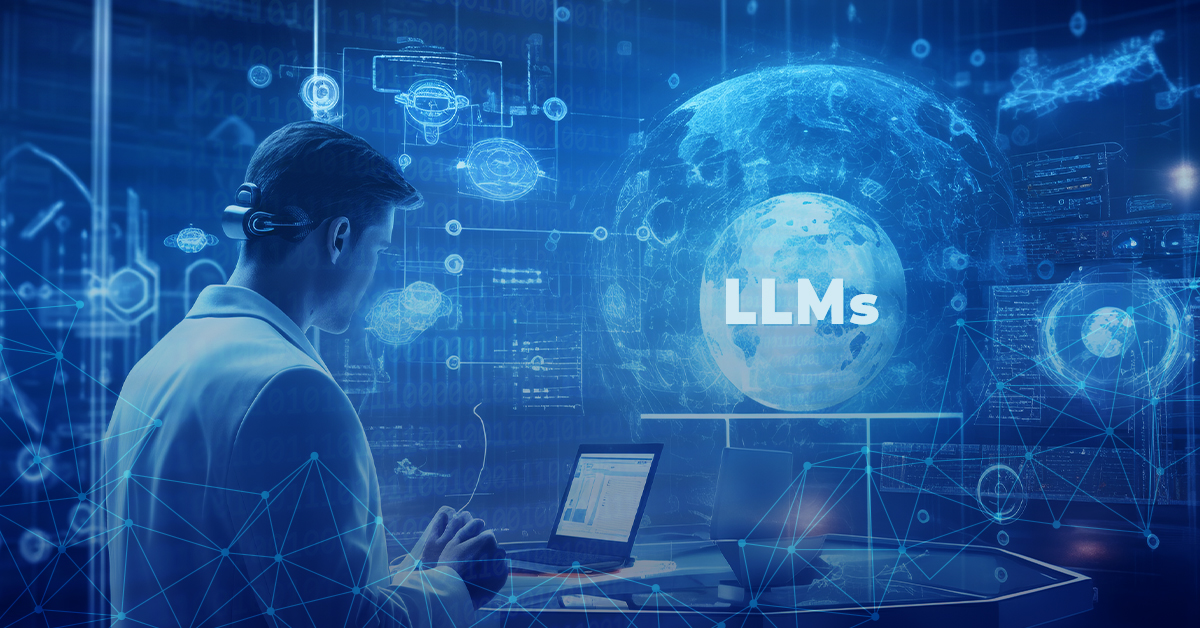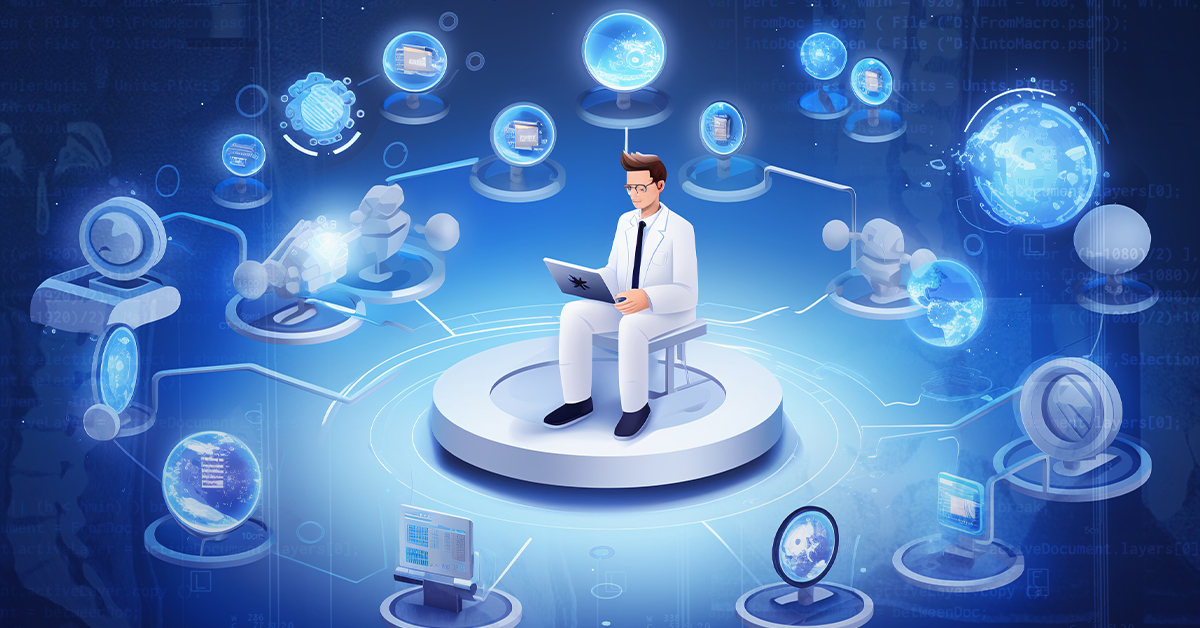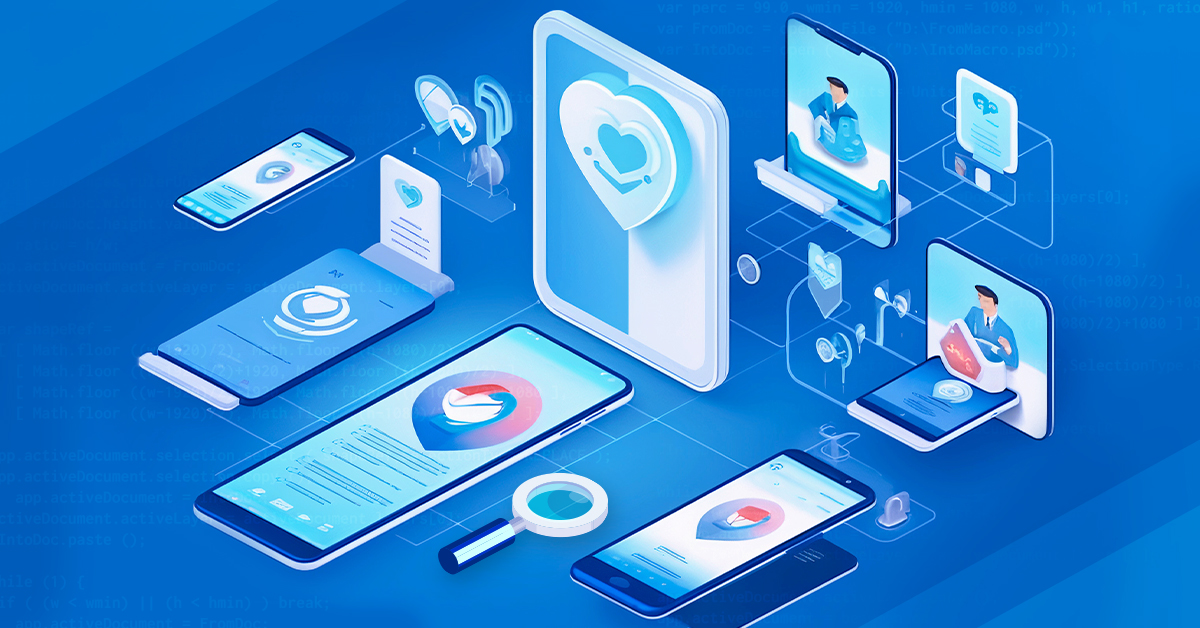What are Medical Large Language Models (LLMs)?
Have you ever wondered how healthcare providers keep up with the constant influx of medical information? How do they sift through mountains of research papers, clinical studies, and patient records to make informed decisions?

Now, picture a technology that can process and understand this vast amount of medical text, just like a human would. Medical or healthcare large language models (LLMs) are advanced artificial intelligence powered domain-specific high-precision systems designed and trained for applications in the healthcare field. They possess the ability to comprehend complex medical texts, extract meaningful information, and generate valuable insights for healthcare professionals.
Depending on the specifics of the databases on which the models were trained, clinical large language models and biomedical LLMs are distinguished. Clinical language models use extensive medical literature on physiology and pathology as training data. Healthcare professionals can use this type of LLM for medical diagnosis and clinical decision support. Biomedical ones make biomedical text mining fast and accessible.
What are the use cases of Large Language models in healthcare? How do they aid physicians in crucial diagnoses and personalized treatment planning for patients with complex conditions? Large language models for healthcare have the capability to process extensive databases of medical literature and patient data, learn from historical cases, and provide valuable insights that aid in accurate and timely diagnosis.
Consider a real-life example where a medical/healthcare large language model analyzes a patient’s symptoms, medical history, and clinical findings, and generates a personalized treatment plan. It can incorporate the latest research findings, treatment guidelines, and even account for individual patient characteristics, all in a matter of seconds. This enables healthcare professionals to make more informed decisions, resulting in improved patient care and outcomes.
Furthermore, healthcare LLMs have the potential to identify potential drug interactions, alerting healthcare providers to potential risks and preventing adverse events. By comprehending and analyzing vast amounts of medical information, these models can play a crucial role in improving patient safety and medication management.
Models Used in Healthcare
Pretrained models in healthcare, such as BioBERT, ClinicalBERT, BlueBERT, and BioGPT, represent significant advancements in the application of AI in the medical field. BioBERT, a variant of the well-known BERT model, is specifically trained on large-scale biomedical corpora, making it highly effective in understanding complex medical texts and terminology. It excels in tasks like disease prediction, drug-drug interaction, and biomedical named entity recognition. ClinicalBERT, adapted from BioBERT, is further fine-tuned on clinical notes, enhancing its performance in clinical natural language processing tasks, particularly in understanding patients’ electronic health records (EHRs). This specialization allows for more accurate patient data analysis and decision support in clinical settings.
BlueBERT, another derivative of BERT, is trained on both biomedical and clinical texts, offering a balanced understanding of both domains. This dual training makes it versatile for a range of applications, from medical research to clinical care. BioGPT, on the other hand, is a generative pretrained transformer model tailored for biomedical applications. It excels in generating coherent and contextually relevant medical text, useful in tasks like medical report generation and answering patient queries. These models, along with others in the field, are pushing the boundaries of AI in healthcare, offering tools for enhanced medical research, improved patient care, and efficient healthcare administration, all while navigating the complexities of medical language and data.
Importance of Medical Large Language Models (LLMs) in Healthcare

The promise of large language models in healthcare is vast and impactful. LLMs have the potential to revolutionize the healthcare industry, offering numerous use cases that can transform patient outcomes and healthcare practices. Explore the significance of language models (LLMs) in the healthcare industry.
- Enhanced Clinical Decision Support: Healthcare large language models (LLMs) provide healthcare professionals with valuable insights and recommendations to support clinical decision-making. By analyzing vast amounts of medical data, including clinical records, research papers, and treatment guidelines, these models assist in accurate diagnoses, personalized treatment planning, and evidence-based decision-making. This leads to improved patient care and outcomes.
- Accelerated Medical Research: Medical large language models (LLMs) have the ability to process and analyze extensive repositories of scientific literature, clinical trials, and patient data. By uncovering patterns, correlations, and insights from this wealth of information, these models aid researchers in accelerating medical discoveries, identifying potential treatments, and advancing our understanding of diseases and their management.
- Improved Patient Engagement: Healthcare large language models (LLMs) empower patients by providing accessible and understandable medical/healthcare information. Through personalized health recommendations, educational resources, and interactive interfaces, these models enable patients to actively participate in their healthcare journeys. They can better understand their conditions, make informed decisions, and engage with healthcare providers, ultimately leading to improved patient engagement and outcomes.
- Streamlined Health Data Management: Managing and extracting relevant information from vast amounts of health data can be a daunting task. Healthcare large language models (LLMs) streamline this process by organizing and extracting valuable insights from various sources such as electronic health records, medical literature, and patient-generated data. This enables healthcare professionals to access and utilize information efficiently, leading to more effective and coordinated care.
- Real-time Clinical Support: In critical situations where timely decisions are crucial, medical large language models (LLMs) can provide real-time clinical support. By continuously analyzing incoming data, such as patient symptoms, vital signs, and medical history, these models can assist healthcare professionals in making rapid and accurate assessments, enabling swift interventions and potentially saving lives.
- Ethical and Regulatory Compliance: With the increasing emphasis on privacy, security, and ethical considerations in healthcare, medical large language models play a vital role in ensuring compliance with regulations and ethical guidelines. By employing techniques such as anonymization and data protection, these models safeguard patient confidentiality and promote responsible use of health data.
Applications of Medical Large Language Models (LLMs) in Healthcare

Healthcare large language models, with their remarkable capabilities, have found diverse applications in the field of healthcare. Let’s delve into some of the key areas where these models are making a significant impact.
Large Language models (LLMs) in Electronic Health Records (EHR) Analysis
Healthcare LLMs can assist in improving the accuracy and efficiency of clinical documentation within EHR systems. They can automatically review and analyze the documentation, identify missing or incomplete information, and suggest appropriate additions or clarifications. For example, Large Language Models can detect discrepancies between diagnoses and treatment plans, ensuring that the documentation reflects the true clinical picture.
Healthcare LLMs can be utilized for predictive analytics within EHR systems. By analyzing historical patient data, LLMs can identify patterns, trends, and potential risks. For example, LLMs can predict the likelihood of readmissions, identify patients at risk for developing certain conditions, or estimate the probability of adverse events based on specific patient characteristics. These insights enable healthcare providers to proactively intervene and provide targeted care.
Large language model for electronic health records can serve as a valuable tool for clinical decision support. By analyzing patient data and comparing it to vast amounts of medical literature and guidelines, LLMs can provide evidence-based recommendations to healthcare providers. For instance, when a physician is entering information into an EHR system, LLMs can automatically suggest relevant treatment options or alert the provider about potential drug interactions or contraindications.
An example of using medical LLMs for EHR analysis is the work done by John Snow Labs in collaboration with healthcare institutions. They have developed LLM-powered solutions that can analyze EHR data to identify patterns of medication non-adherence. By analyzing patient records and clinical notes, the LLM can flag instances where patients may not be following prescribed medication regimens. This enables healthcare providers to intervene and improve patient adherence, leading to better health outcomes.
Large Language models (LLMs) in Clinical Text Analysis
Healthcare Large Language Models (LLMs) are employed for Clinical Text Analysis to extract insights from unstructured clinical texts, such as electronic health records, discharge summaries, and clinical notes. These models utilize natural language processing techniques to understand and interpret the content of the text, enabling various applications in healthcare.
For example, healthcare LLMs can be utilized to identify and extract key information from radiology reports. These reports often contain detailed descriptions of medical imaging findings, including the presence of abnormalities, anatomical locations, and clinical interpretations. By applying Clinical Text Analysis, medical LLMs can automatically extract these data, allowing for efficient indexing and retrieval of relevant information. This aids radiologists in quickly accessing and reviewing critical information, contributing to timely and accurate diagnoses.
Additionally, healthcare LLMs can assist in adverse drug event monitoring by analyzing unstructured text data, such as electronic health records and clinical notes. By extracting mentions of drug names, dosage information, and reported adverse reactions, these models can identify potential drug safety concerns. For instance, if a healthcare LLM detects a high frequency of adverse reactions associated with a specific medication, it can raise red flags and prompt further investigation by healthcare providers or regulatory agencies. This supports pharmacovigilance efforts and contributes to patient safety.
Large Language models (LLMs) in Drug Discovery and Development
Medical LLMs have significant potential in the field of drug discovery and development. They can analyze vast amounts of biomedical literature, scientific papers, and clinical data to identify potential drug targets. These models can extract relevant information about disease mechanisms, protein interactions, and genetic factors associated with specific diseases. This helps researchers identify novel drug targets and validate their potential efficacy. For example, LLMs can be used to analyze genomic data and identify genetic markers associated with a disease, enabling the development of targeted therapies.
Medical LLMs can assist in finding new applications for existing drugs, a process known as drug repurposing. By analyzing extensive datasets and literature, LLMs can identify potential connections between drugs and diseases that were not originally intended. This approach can significantly reduce the time and cost involved in developing new drugs. For instance, LLMs can analyze drug databases and medical literature to identify existing drugs that may be effective in treating other diseases or conditions. This has the potential to accelerate the availability of treatments for various medical conditions.
Large Language models (LLMs) in Medical Image Analysis
Medical large language models (LLMs) can be combined with medical imaging technologies to assist in the analysis and interpretation of medical images. By integrating textual information with visual data, LLMs can aid in the detection of abnormalities, assist in diagnosis, and provide additional context for radiologists and other medical professionals.
Large Language models (LLMs) in Natural Language Understanding for Patient Queries
Healthcare large language models (LLMs) are utilized in healthcare chatbots and virtual assistants to understand and respond to patient queries. These models can interpret natural language input from patients, provide accurate answers, offer basic medical/healthcare advice, and direct patients to appropriate resources. LLM-powered chatbots enhance patient engagement and provide instant access to healthcare information.
Training and Development of Medical Large Language Models (LLMs)
Training and developing healthcare large language models (LLMs) involves several key steps. Firstly, a vast amount of relevant medical/healthcare data is collected, including electronic health records, medical literature, and clinical notes. This data is carefully preprocessed and annotated to ensure its quality and relevance.
Next, the preprocessed data is used to train the LLM using advanced machine learning techniques. This involves utilizing deep learning architectures, such as transformer models, to capture the complex patterns and semantic relationships within the medical text. The training process typically requires substantial computational resources and can take a considerable amount of time.
The pre-training phase of Large Language Models (LLMs), including medical LLMs, can be done in an unsupervised or self-supervised manner, where labeled data is not required, the challenge of labeled data primarily arises in the fine-tuning phase for downstream tasks such as Named Entity Recognition (NER) and classification.
During fine-tuning, medical LLMs are trained on specific labeled datasets to adapt the model to perform specific tasks within the healthcare domain. These labeled datasets are crucial for training the model to accurately recognize medical entities, classify medical texts, and perform other healthcare-related tasks. Gathering and annotating large amounts of labeled data for medical tasks can be time-consuming, expensive, and challenging due to the need for domain expertise. Additionally, ensuring the privacy and security of sensitive patient information during the training process is crucial.
Looking ahead, ongoing advancements in natural language processing and machine learning techniques hold great promise for the future development of medical LLMs. Continued research aims to improve the models’ accuracy, scalability, and efficiency, allowing them to handle larger and more diverse medical datasets. Additionally, incorporating domain-specific knowledge and expanding the models’ understanding of medical concepts and terminology will further enhance their performance.
By addressing these challenges and leveraging future developments, medical LLMs have the potential to revolutionize healthcare by providing clinicians with powerful tools for decision support, improving patient outcomes, and advancing medical research.
State-of-the-Art Medical Large Language Models (LLMs)
The field of Healthcare NLP has witnessed remarkable progress with the emergence of state-of-the-art medical LLMs (large language models) developed by John Snow Labs. These advanced models have demonstrated superior performance and achieved significant milestones, surpassing other popular language models in the healthcare domain.

Large language Models (LLMs) in Clinical Note Summarization
John Snow Labs’ Large Language Models (LLMs) are claimed to achieve 30% higher accuracy in summarizing clinical notes compared to other models like BART, Flan-T5, and Pegasus. This implies that their models excel at extracting essential information and generating concise summaries from complex clinical documents, enabling efficient review and understanding by healthcare professionals.
Large language Models (LLMs) in Clinical Entity Recognition
Clinical entity recognition involves identifying and extracting specific entities such as medical conditions, symptoms, medications, and procedures from clinical texts. John Snow Labs’ Large Language Models (LLMs) demonstrate a significantly lower error rate in clinical entity recognition compared to ChatGPT. The claim suggests that their LLMs exhibit a higher level of accuracy in this critical task.
Large language Models (LLMs) in Extracting ICD-10-CM Codes
John Snow Labs’ Large Language Models (LLMs) achieve a 76% success rate in extracting ICD-10-CM codes, which are standardized medical codes used for classifying diagnoses and procedures. In contrast, GPT-3.5 and GPT-4 achieve success rates of 26% and 36%, respectively. This indicates that John Snow Labs’ large language models outperform other models in accurately capturing and assigning relevant medical codes, facilitating proper documentation and coding practices.
Challenges and limitations
There are some challenges and limitations of Large Language Models usage in healthcare. They include:
- Data Privacy and Security: Ensuring the confidentiality and security of sensitive patient data is a major concern, especially given the strict regulations in healthcare like HIPAA.
- Bias and Inaccuracy: Medical LLMs may inherit biases present in their training data, leading to skewed or inaccurate medical advice and diagnoses.
- Lack of Contextual Understanding: LLMs might struggle with understanding the full context of a patient’s medical history or condition, which can lead to inappropriate recommendations.
- Generalization vs. Specialization: While LLMs are trained on vast datasets, they may not be specialized enough for rare diseases or specific medical conditions.
- Regulatory and Ethical Challenges: Navigating the complex regulatory landscape of healthcare and addressing ethical concerns related to AI decision-making is challenging.
- Dependency and Overreliance: There’s a risk of healthcare professionals becoming overly reliant on LLMs, potentially undermining their clinical judgment.
- Integration with Healthcare Systems: Integrating LLMs into existing healthcare IT systems and workflows can be complex and resource-intensive.
- Continuous Updating: Medical knowledge constantly evolves, requiring LLMs to be regularly updated, which can be a resource-intensive process.
The promise of large language models in healthcare: Conclusion
In a world where medical literature, clinical records, and scientific papers are analyzed with remarkable precision and speed, the role of large language models in transforming healthcare is truly significant. LLM for medicine is the driving force behind this transformative shift. By harnessing the power of language processing, machine learning, and natural language understanding, LLMs empower healthcare professionals to access a wealth of knowledge, improve diagnoses, personalize treatments, and ultimately enhance patient outcomes.
From clinical note summarization to clinical entity recognition and extracting ICD-10-CM codes, John Snow Labs’ Medical large language models have consistently demonstrated superior accuracy and efficiency. These models enable healthcare professionals to access and comprehend vast amounts of medical information, leading to improved diagnoses, personalized treatments, and enhanced patient outcomes.
Take a step towards revolutionizing healthcare with John Snow Labs’ medical large language models. Visit our website to learn more about our cutting-edge solutions and unlock the full potential of AI-powered healthcare.
FAQs about the use of Medical Large Language models (LLMs) in Healthcare
Here are some frequently asked questions about the use of medical large language models in healthcare.
1. What are Medical Large Language Models (LLMs) and how are they used in healthcare?
Medical Large Language Models are advanced AI-powered language models specifically designed for healthcare applications. These models leverage natural language processing techniques to analyze and interpret medical texts, enabling healthcare professionals to access valuable insights and knowledge. Large Language Models (LLMs) play a crucial role in tasks such as clinical documentation, medical research, and patient care.
2. How do medical large language models (LLMs) improve patient care?
Medical large language models enhance patient care by analyzing vast amounts of medical literature, clinical records, and scientific papers with precision and speed. They provide valuable insights, aid in accurate diagnoses, assist in treatment planning, and support healthcare professionals in making informed decisions.
3. Can medical large language models (LLMs) be customized for specific healthcare needs?
Yes, medical large language models can be fine-tuned and customized for specific healthcare applications. They can be trained on domain-specific data to improve performance and relevance in areas such as radiology, pathology, pharmacology, and more.
4. Are there any ethical considerations with the use of medical large language models (LLMs)?
Ethical considerations, such as patient privacy and data security, are of utmost importance when utilizing medical large language models. It is crucial to adhere to privacy regulations and implement robust security measures to protect patient information and maintain confidentiality.
5. Can large language models assist in multilingual healthcare environments?
Yes, large language models can be trained on multilingual datasets, allowing them to analyze and interpret medical texts in multiple languages. This capability is particularly valuable in diverse healthcare settings where patients and medical records may be in different languages. Medical large language models enable accurate translation, cross-lingual analysis, and facilitate communication between healthcare professionals and patients from various linguistic backgrounds.





























